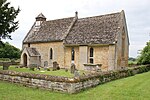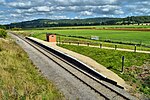Hailes Abbey
1245 establishments in England1539 disestablishments in EnglandChristian monasteries established in the 13th centuryCistercian monasteries in EnglandCommons category link is locally defined ... and 14 more
English Heritage sites in GloucestershireGrade I listed churches in GloucestershireGrade I listed monasteriesMonasteries dissolved under the English ReformationMonasteries in GloucestershireMuseums in GloucestershireNational Trust properties in GloucestershireReligious museums in EnglandReligious organizations established in the 1240sRuins in GloucestershireScheduled monuments in GloucestershireStanway, GloucestershireTourist attractions in GloucestershireUse British English from February 2023

Hailes Abbey is a former Cistercian abbey, in the small village of Hailes, two miles northeast of Winchcombe, Gloucestershire, England. It was founded in 1246 as a daughter establishment of Beaulieu Abbey. The abbey was dissolved by Henry VIII in 1539. Little remains of the abbey. It is a Grade I listed building and a scheduled monument. The site is owned by the National Trust but managed by English Heritage. There is a museum on the site holding many artefacts from the Abbey.
Excerpt from the Wikipedia article Hailes Abbey (License: CC BY-SA 3.0, Authors, Images).Hailes Abbey
Salter's Lane, Tewkesbury Stanway
Geographical coordinates (GPS) Address Nearby Places Show on map
Geographical coordinates (GPS)
| Latitude | Longitude |
|---|---|
| N 51.968333333333 ° | E -1.9280555555556 ° |
Address
Hailes Abbey
Salter's Lane
GL54 5PB Tewkesbury, Stanway
England, United Kingdom
Open on Google Maps









